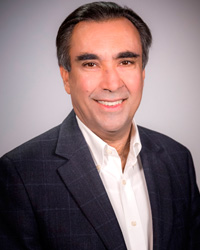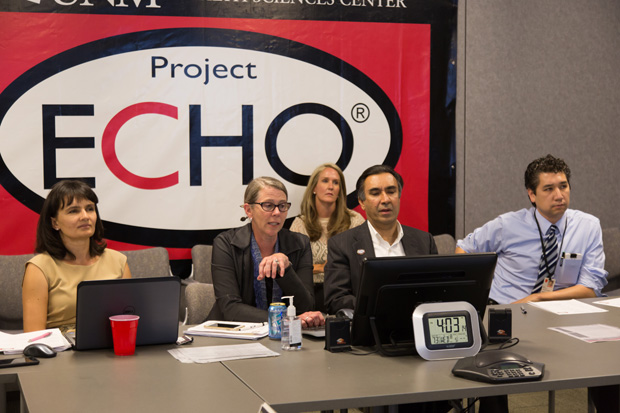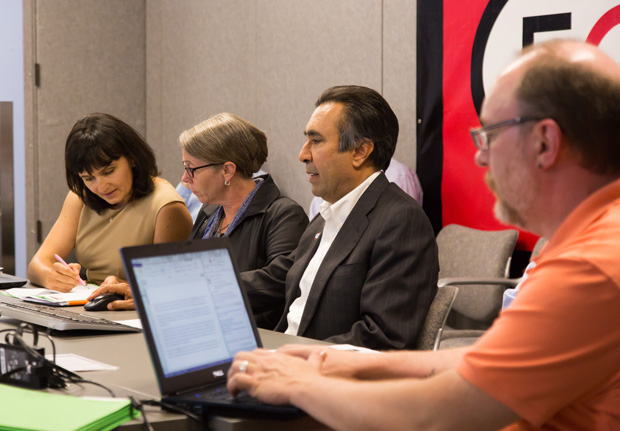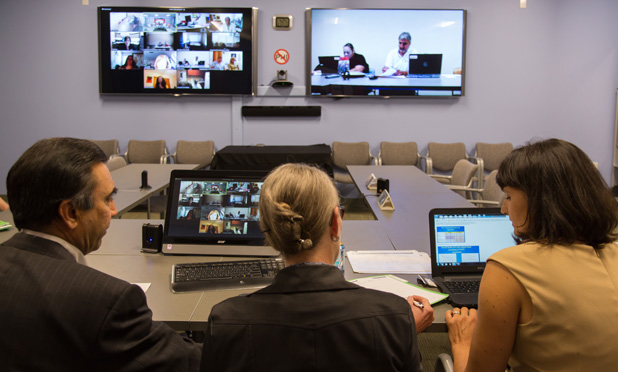Much like some other regions of the United States, the American Southwest is home to large open spaces in which the majority of people and services are concentrated in one or two regional cities, while the rest of the population is scattered among small towns and rural areas. The state of New Mexico is no exception, and its relatively low population poses particular challenges to healthcare access, especially for those with chronic diseases who require specialty care. In response, Project ECHO, based at the School of Medicine at the University of New Mexico in Albuquerque, aims to improve patient treatment access through an innovative model that democratizes health care not only in New Mexico, but around the world.

Project ECHO, which stands for Extension for Community Healthcare Outcomes, is a collaborative model of medical education and care management that empowers clinicians by providing the mentoring they need to treat their patient’s complex conditions where they live. Now with hubs in over 30 states and 16 countries outside the U.S., the ECHO model has proven to be an effective way to improve health care among underserved populations as well as a means to share knowledge of best practices. IEEE Pulse spoke with Dr. Sanjeev Arora, founder and director of Project ECHO (pictured, right), about rural health care challenges and the novel solutions his organization offers.
IEEE Pulse: What motivated you to found Project ECHO?
Arora: As a gastroenterologist and liver disease specialist, I run a hepatitis C clinic at the University of New Mexico. Hepatitis C is a disease that affects more than 170 million people worldwide, about 35,000 of whom live in New Mexico. Back in 2003, about 28,000 patients had been diagnosed in New Mexico but less than 5% were undergoing treatment. Also, there were 2400 prisoners in the state who had this disease and none had received treatment.
At that time, there was a cure but it involved a very complicated chemotherapy-like regimen and there weren’t enough specialists available to treat patients. Instead, people were driving from all over the state to come for treatment in my clinic at the university, making between 12 to 18 trips. But the bigger problem was that there was an 8-month wait to see me, so if you were poor and couldn’t afford to travel, it was really impossible to get treatment and people were dying as a result.
This was the problem I was trying to fix. I wanted to bring treatment access to everyone in New Mexico and if I could do that, then I knew we would have a model to treat complex diseases in rural locations and in developing countries all over the world.
IEEE Pulse: What makes Project ECHO unique in comparison to other telehealth efforts?
Arora: What makes Project ECHO unique is that it demonopolizes the knowledge of a multi-disciplinary team of experts. For example, in order to get people treatment for hepatitis C, it requires a liver specialist, a psychiatrist, and a pharmacist, and these were not available in rural areas, so we had to figure out a way to bring this expertise to them. But the challenge was that if we just started seeing patients using technology, then eventually our professional time would be consumed by these rural patients and the patients here in Albuquerque couldn’t be seen, so it would be a zero sum game.
Ultimately, we wouldn’t be treating many more patients by sitting in front of a camera and, in fact, we might be seeing even fewer patients because we would be a little less efficient than if we were seeing them in person. That is why we developed a new model, and the goal of this model is what we call ‘force multiplication’, that is, we want to logarithmically improve the capacity to deliver care—up to 10 to 100 times more capacity. Why is this necessary? For the nearly 7 billion people in this world, we believe 6 billion people don’t have access to the right knowledge at the right place at the right time, and millions of people die as a result.
What we had to do instead was focus on moving knowledge instead of moving patients. For the hepatitis C project, we created 21 Centers of Excellence for treating the disease all over the state, five in the prison system and 16 in federally-qualified health centers. These were organizations that already had the job of bringing health care to an impoverished patient population. What’s unique about our model is that it’s a way to mentor the primary care physicians so they become as good as specialists, for long term capacity addition.

IEEE Pulse: How does the model work?
Arora: The model we designed has multiple parts. First, we use technology to leverage the expertise of a multidisciplinary team of specialists at the university. We also share our best practices, so in this case, each of these centers was run by a nurse practitioner or a physician assistant or a family doctor and the specialists shared their own protocols with them. However, the challenge was how were we going to make a family doctor as good as a multidisciplinary team? The answer was to use case-based learning. What that means is that once every week, everyone would join in an interactive video network with the multidisciplinary team and one by one, the clinicians would present patients to us and to each other. In a two-hour time period, we would discuss about ten patients and provide them with a 15-minute lecture.
We call this a ‘knowledge network’ and the way the clinicians become experts is through a learning loop—they learn from us, from our advice and from our lectures. They learn from each other because they may bring only one patient to the network a week, but they learn on 10, which equates to 500 patients every term. We tracked outcomes on the internet and as the model was in place week after week, a few important things happened: the participants’ professional satisfaction went up, their professional isolation went down, their self-efficacy in treating hepatitis C with this chemotherapy-like regimen went up dramatically, and over time, they started becoming as good as us.
In addition, the wait in my clinic fell from 8 months to 2 weeks over the course of 18 months because patients could be seen by their local expert instead of having to come to the university. Forced multiplication had occurred. We then did a study that was published in the New England Journal of Medicine where we showed that the cure rates of hepatitis C in the rural areas and in prisons were as high as in the university. This supported our claim that these clinicians could do as good a job as a multidisciplinary team, and that they could do it safely and effectively.
This is what actually led to expanding the model to 20 different disease areas in New Mexico. Now we are in 16 countries outside the U.S. and have over 50 university hubs in the United States. Project ECHO is expanding to 50 different disease areas, because once the model proved to be working beautifully for such a complicated problem like hepatitis C it started getting rapidly adopted for HIV care in Africa, for hepatitis C elimination in the country of Georgia, for substance abuse disorders and HIV in the U.S., as well as for diabetes and many other conditions.
IEEE Pulse: What have been the challenges to enacting this model?
Arora: In the U.S., the major challenge is that payment for healthcare services is all related to seeing a patient and treating a patient. And for academic medical centers, our revenue is generated when patients come to see us. There is no business model right now for training other doctors in the world or other doctors in New Mexico so that the care system as a whole improves. Also, in the primary care setting, the clinicians are not getting paid to see more complex patients and learning to treat these patients, so any time they spend getting mentored by experts is not reimbursed in any way.
We would like to see a healthcare system where there is some incentive for large universities to engage in capacity building so people can get the care at the right place, at the right time, and close to their home as opposed to traveling long distances. But this is against the prevailing paradigm of health care; there are no incentives for demonopolizing knowledge and democratizing it and there is no payment system yet developed for this.
IEEE Pulse: Are there also telecommunication concerns?
Arora: Theoretically, technology appears to be a major concern but in practice most rural areas in the U.S. have enough broadband access. The kind of technology we use works very effectively on mobile phones, and we use a platform that only requires 3G. You can always make the case that there are a few places where there is not enough bandwidth but even in those situations if the clinician travels 10-15 miles to their local library for that one video session each week it would be workable. With the ECHO model, technology access is not really an issue.
Rather, it is this other issue of incentives and what is valued by the healthcare system that is the main challenge to overcome.

IEEE Pulse: Where do you see Project ECHO having its biggest impacts in the next decade?
Arora: I think the biggest impact will be in rural areas and urban underserved areas of the U.S. where it is very difficult for poor patients, Medicaid patients, and people without insurance to actually access specialty care. Another area is, of course, that knowledge is increasing at an exponential pace and so primary care physicians are finding it very hard to keep up. ECHO allows them to have a mentor at the university to help them keep pace with the knowledge so that they can provide the best care to their patients.
Also, ECHO is an innovative way to spread existing best practices. Some of these best practices could have existed for 50 years but in rural Kenya they still don’t have access to them. One way to look at it is that the ECHO model provides a way to spread innovation—new best practices will be discovered every day, every year, and ECHO will be able to share those innovations. So first, it is an innovation to spread best practices, and then it is an innovation to spread innovation, too.
Other areas where there will be maximum impact is in the least developed world. We have a major program in the country of Namibia where currently they have 120,000 HIV patients and only half are on treatment. ECHO is a powerful way to get everyone on treatment by connecting all the rural hospitals, which we are doing, and then the teams are getting trained to treat HIV.
Beyond health care, we are also embarking now into the field of education where it’s about training schoolteachers to become better prepared and mentoring them in a variety of areas. We have several projects going on both in the U.S. and internationally, and I think that will be a huge field over the next decade for ECHO.
IEEE Pulse: What are the schoolteachers being trained in?
Arora: In different places, different things. For one project in Wyoming, teachers are being trained on assistive technologies to help disabled children, and school principals and district superintendents are being trained on leadership of public school systems and compliance issues, such as those related to transgender students. In India, we have projects to train teachers to become better math, or English writing teachers.
The mentors that work with these projects are master teachers and it’s not just about content, it’s also about classroom management, about listening skills, about the use of technology to transfer concepts more easily.
IEEE Pulse: It’s interesting to see how this model can be applied not only in the healthcare field but to other underserved areas as well. One final question: What would you like to see for the future?
Arora: I would like to see a world in which highly specialized knowledge, no matter which field it is in—whether it is in the field of environmental clean up or in the field of education, and most of all, in the field of improving health and health care—is democratized. A world where knowledge is seen as something that has to be shared, and experts see their role in the world not as keeping knowledge to themselves for personal or organizational gain but instead they want to share it freely for the good of humanity.
IEEE Pulse: That would be a beautiful world and I look forward to such a future. Thank you.



